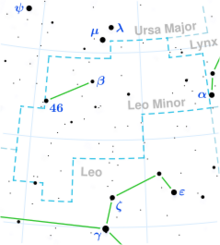Astronomy:46 Leonis Minoris
| Observation data Equinox J2000.0]] (ICRS) | |
|---|---|
| Constellation | Leo Minor |
| Right ascension | 10h 53m 18.70487s[1] |
| Declination | +34° 12′ 53.5375″[1] |
| Apparent magnitude (V) | 3.83[2] (3.79–3.84[3]) |
| Characteristics | |
| Evolutionary stage | red clump[4] |
| Spectral type | K0+ III-IV[5] |
| Variable type | suspected[3] |
| Astrometry | |
| Proper motion (μ) | RA: +92.02[1] mas/yr Dec.: −285.82[1] mas/yr |
| Parallax (π) | 34.38 ± 0.21[1] mas |
| Distance | 94.9 ± 0.6 ly (29.1 ± 0.2 pc) |
| Absolute magnitude (MV) | +1.45[6] |
| Details | |
| Mass | 1.69[7] M☉ |
| Radius | 8.22 ± 0.22[2] R☉ |
| Luminosity | 34 ± 2[2] L☉ |
| Surface gravity (log g) | 2.96[2] cgs |
| Temperature | 4,670[2] K |
| Metallicity [Fe/H] | −0.20[8] dex |
| Rotational velocity (v sin i) | 1.81[9] km/s |
| Age | 6.76[4] Gyr |
| Other designations | |
| Database references | |
| SIMBAD | data |
46 Leonis Minoris (abbreviated 46 LMi), also named Praecipua /prɪˈsɪpjʊə/,[10] is the brightest star in the constellation of Leo Minor. It is of spectral class K0+III-IV and of magnitude 3.83. It is a red clump giant.[4] Based upon parallax measurements, its distance from the Sun is approximately 95 light-years. It is a suspected variable with an amplitude of about 0.05 magnitudes.[3]
Nomenclature
46 Leonis Minoris is the star's Flamsteed designation. It is sometimes designated "o LMi" (not "ο LMi"), from Bode's catalogue of 1801. It was presumably intended to be designated α, as Francis Baily decided to letter each star brighter than magnitude 4.5, but the designation was missing from his catalogue, even though the dimmer β was included.[11]
It bore the traditional proper name Praecipua, derived from the Latin for "the Chief (Star of Leo Minor)".[12] The name may originally have referred to 37 Leonis Minoris, and later mistakenly transferred to this star.[13] In 2016, the International Astronomical Union (IAU) organized a Working Group on Star Names (WGSN)[14] to catalog and standardize proper names for stars. The WGSN approved the name Praecipua for this star on 30 June 2017 and it is now so included in the List of IAU-approved Star Names.[10]
It is known as 勢四, "the Fourth (Star) of the Eunuch", in traditional Chinese astronomy.[citation needed]
See also
References
- ↑ Jump up to: 1.0 1.1 1.2 1.3 1.4 van Leeuwen, F. (November 2007), "Validation of the new Hipparcos reduction", Astronomy and Astrophysics 474 (2): 653–664, doi:10.1051/0004-6361:20078357, Bibcode: 2007A&A...474..653V
- ↑ Jump up to: 2.0 2.1 2.2 2.3 2.4 Piau, L. et al. (February 2011), "Surface convection and red-giant radius measurements", Astronomy and Astrophysics 526: A100, doi:10.1051/0004-6361/201014442, Bibcode: 2011A&A...526A.100P
- ↑ Jump up to: 3.0 3.1 3.2 Samus, N. N. et al. (2009). "VizieR Online Data Catalog: General Catalogue of Variable Stars (Samus+ 2007–2013)". VizieR On-line Data Catalog: B/GCVS. Originally Published in: 2009yCat....102025S 1. Bibcode: 2009yCat....102025S.
- ↑ Jump up to: 4.0 4.1 4.2 Soubiran, C.; Bienaymé, O.; Mishenina, T. V.; Kovtyukh, V. V. (2008). "Vertical distribution of Galactic disk stars. IV. AMR and AVR from clump giants". Astronomy and Astrophysics 480 (1): 91–101. doi:10.1051/0004-6361:20078788. Bibcode: 2008A&A...480...91S.
- ↑ Keenan, Philip C.; McNeil, Raymond C. (1989). "The Perkins catalog of revised MK types for the cooler stars". Astrophysical Journal Supplement Series 71: 245. doi:10.1086/191373. Bibcode: 1989ApJS...71..245K.
- ↑ Mullan, D. J.; MacDonald, J. (2003). "Onset of Mass Loss in Red Giants: Association with an Evolutionary Event". The Astrophysical Journal 591 (2): 1203. doi:10.1086/375446. Bibcode: 2003ApJ...591.1203M.
- ↑ Lyubimkov, L. S.; Poklad, D. B. (2014). "Determining the effective temperatures of G- and K-type giants and supergiants based on observed photometric indices". Kinematics and Physics of Celestial Bodies 30 (5): 244. doi:10.3103/S0884591314050055. Bibcode: 2014KPCB...30..244L.
- ↑ Wittenmyer, Robert A.; Gao, Dongyang; Hu, Shao Ming; Villaver, Eva; Endl, Michael; Wright, Duncan (2015). "The Weihai Observatory Search for Close-in Planets Orbiting Giant Stars". Publications of the Astronomical Society of the Pacific 127 (956): 1021. doi:10.1086/683258. Bibcode: 2015PASP..127.1021W.
- ↑ Hekker, S.; Meléndez, J. (2007). "Precise radial velocities of giant stars. III. Spectroscopic stellar parameters". Astronomy and Astrophysics 475 (3): 1003. doi:10.1051/0004-6361:20078233. Bibcode: 2007A&A...475.1003H.
- ↑ Jump up to: 10.0 10.1 "Naming Stars". IAU.org. https://www.iau.org/public/themes/naming_stars/.
- ↑ Wagman, Morton (2003). Lost Stars. Blacksburg, Virginia: McDonald and Woodward. ISBN 0-939923-78-5.
- ↑ Allen, R. H. (1963). Star Names: Their Lore and Meaning (Reprint ed.). New York City , NY: Dover Publications Inc.. p. 264. ISBN 0-486-21079-0.
- ↑ Leo Minor: The little lion- Ian Ridpath's Star Tales
- ↑ "IAU Working Group on Star Names (WGSN)". https://www.iau.org/science/scientific_bodies/working_groups/280/.
 |


